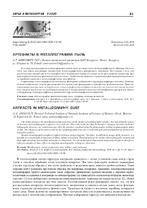| dc.contributor.author | Анисович, А. Г. | |
| dc.coverage.spatial | Минск | ru |
| dc.date.accessioned | 2020-10-09T10:36:50Z | |
| dc.date.available | 2020-10-09T10:36:50Z | |
| dc.date.issued | 2020 | |
| dc.identifier.citation | Анисович, А. Г. Артефакты в металлографии: пыль = Artifacts in metallography: dust / А. Г. Анисович // Литье и металлургия. – 2020. – № 3. – С. 93-98. | ru |
| dc.identifier.uri | https://rep.bntu.by/handle/data/80752 | |
| dc.description.abstract | В статье рассматривается идентификация частиц пыли на поверхности металлографических образцов. Отмечается, что объем литературы, посвященной металлографическим артефактам, небольшой. Это связано с тем, что русскоязычная литература металлографического направления создавалась давно, когда фиксирование структуры проводили фотометодом на фотопластинки или пленку. Трудоемкость процесса и недостаток фотоматериалов исключали наработку сведений о металлографических артефактах. Современные металлографические комплексы фиксируют изображения структуры цифровым способом. Поэтому, помимо изображений структуры, возможно без ограничений фиксировать и артефакты пробоподготовки. Проиллюстрированы частицы пыли на поверхности металлографических шлифов и их отличие от неметаллических включений. Рассмотрено применение темнопольного освещения и поляризованного света для идентификации артефактов. Проиллюстрированы некоторые эффекты, возникающие при металлографическом травлении. | ru |
| dc.language.iso | ru | ru |
| dc.publisher | БНТУ | ru |
| dc.title | Артефакты в металлографии: пыль | ru |
| dc.title.alternative | Artifacts in metallography: dust | ru |
| dc.type | Article | ru |
| dc.identifier.doi | 10.21122/1683-6065-2020-3-93-98 | |
| local.description.annotation | The article discusses the identification of dust particles on the surface of metallographic samples. It is noted that the volume of literature on metallographic artifacts is very small one. This is due to the fact that the Russian – language literature of the metallographic direction was wtitten long ago when the structure was fixed using the photographic method on photographic plates or film. The complexity of the process and the lack of photographic materials excluded the generation of information about metallographic artifacts. Modern metallographic complexes capture structure images digitally. Therefore, in addition to images of the structure, it is possible to record sample preparation artifacts without restrictions. Dust particles on the surface of metallographic sections and their difference from non-metallic inclusions are illustrated. The use of dark-field illumination and polarized light to identify artifacts is considered. Some effects arising from metallographic etching are illustrated. | ru |

